This crab risotto is bright, creamy, and full of Dungeness crab. The star of this dish is the beautiful crab meat; and because we want that to shine, it's paired with fresh herbs and lemon to keep it light.
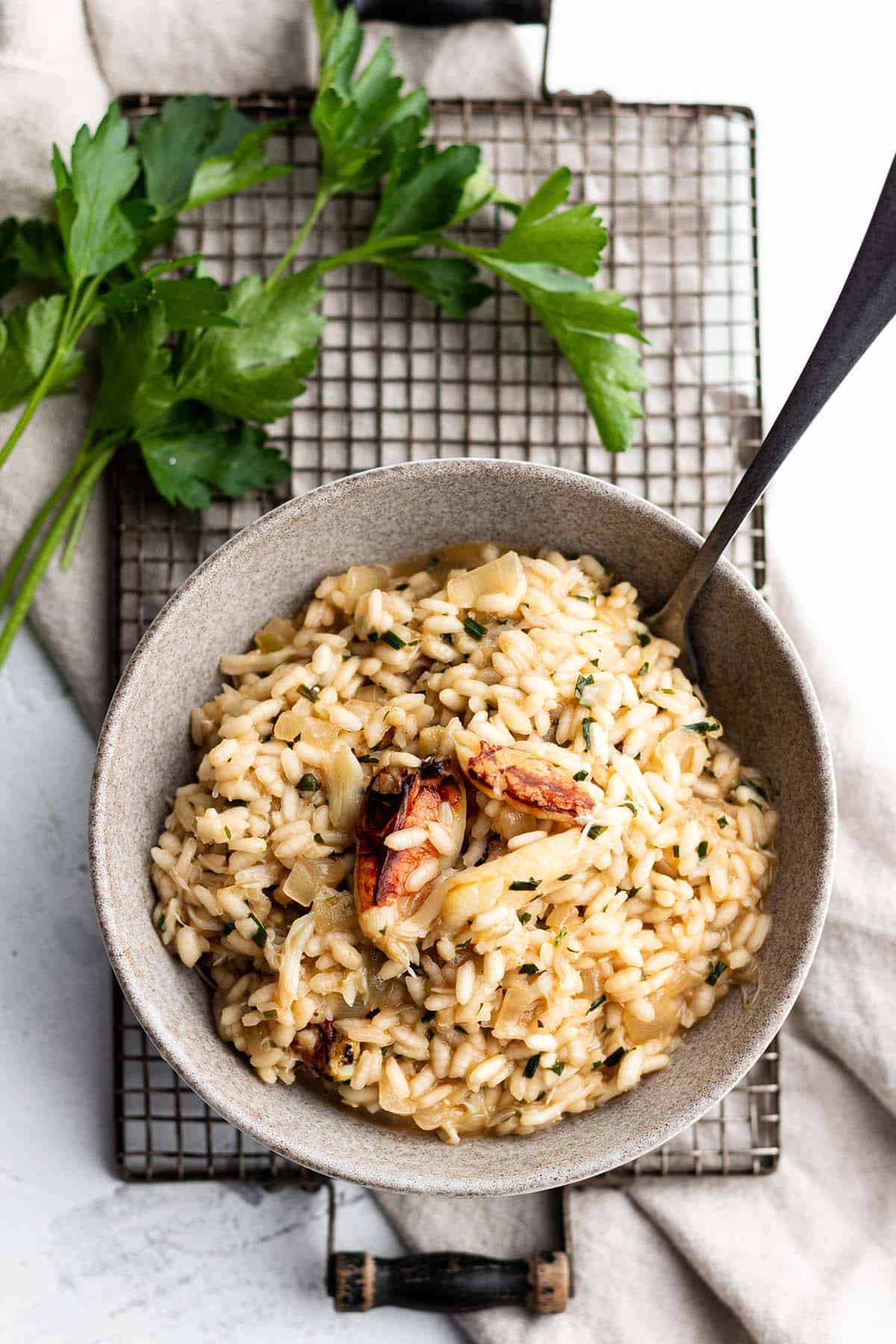
If you are a risotto fan and a seafood lover, this version is for you.
While risotto is not an easy dish to make, with some practice it can be done at home and turn out way better than from a restaraunt. Just follow my tips below to make the best homemade risotto.
I enjoy making all kinds of risotto, but adding fresh Dungeness crab meat has to be one of my favorites.
It's full of fresh white crab meat, herbs, lemon, and that creamy risotto.
Do you love crab? Check out this hot and cheesy crab dip or a cold crab dip and a long list of things to serve with crab dip. Or maybe a crab bisque or crab deviled eggs are more your style.
Do you have your own fresh crab and need help cooking and processing it? Check out my how to cook and clean Dungeness crab post and then add it to any of these Dungeness crab recipes.
Jump to:
🍚Ingredients
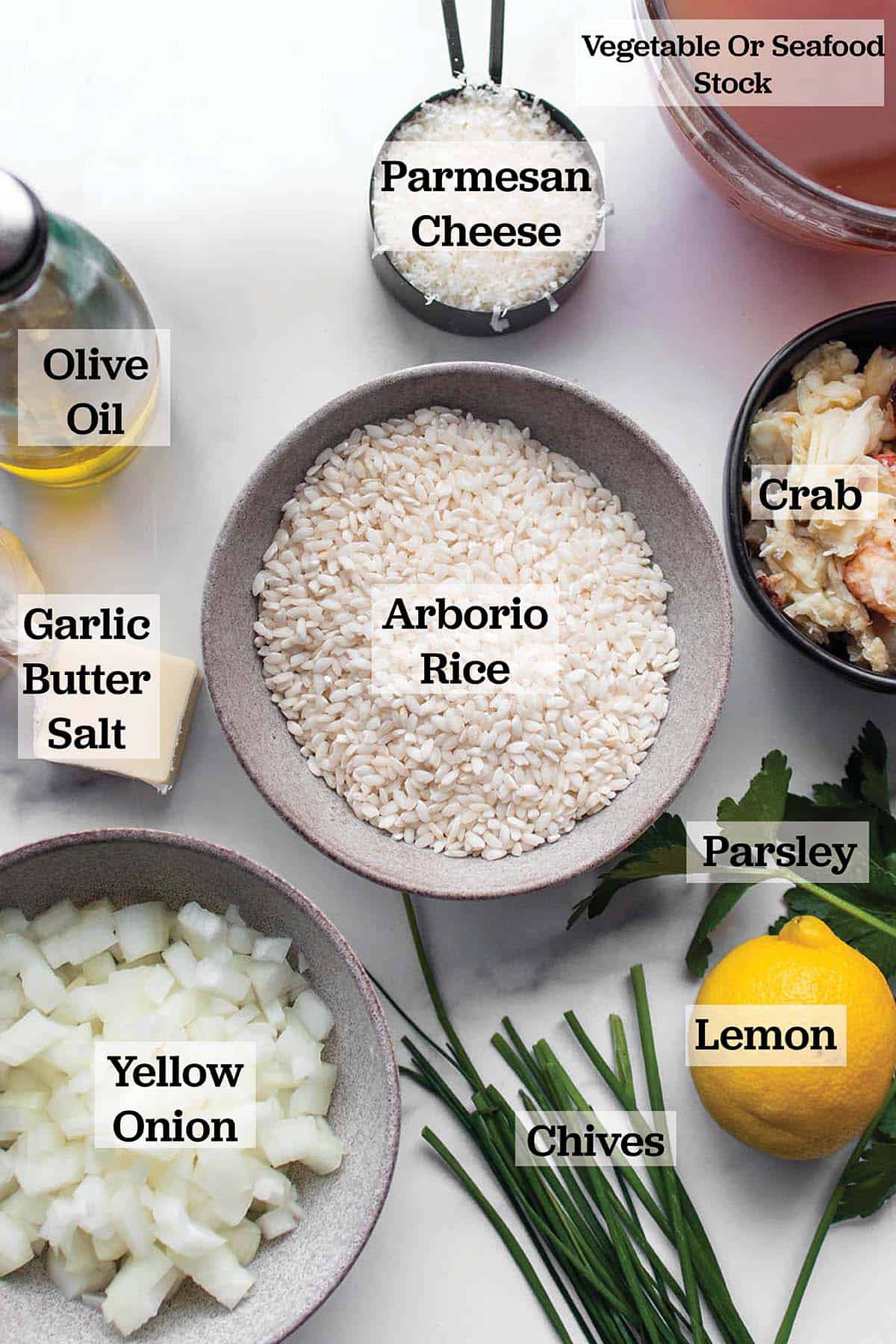
Crab: This recipe calls for Dungeness crab, but any crab can be used. Anywhere from 8 oz - 1lb of crab, depending on how much you want to use.
Honestly, 8 ounces is a great amount and still gives you tons of crab per bite. It is also a lot cheaper. Putting an entire pound in this recipe just isn't necessary unless you want to use that much crab.
Fresh herbs: We want the crab to really stand on its own. Luckily, crab goes so well with fresh herbs. This recipe calls for chives and parsley.
Dried can also be used. Just substitute 1 teaspoon dried for 1 tablespoon of fresh.
Lemon Juice: Fresh lemon is a great compliment to crab. It also helps add more freshness to this dish.
Risotto rice: The rice needed to make risotto is an arborio rice or carnaroli rice. Long-grain white rice cannot be used. I find arborio easier to find and cheaper.
Stock: A seafood stock or crab broth would be the preferred option to make a crab risotto. Both can be expensive, or hard to find, so a vegetable stock works well in its place.
Parmesan: Make sure it is freshly grated. The pre-grated bag stuff just won't melt properly.
See full information on ingredients and quantities in the recipe card.
🫕Best Pot to Make a Risotto?
The best cookware to make risotto is a pan or skillet. Preferably one that has a heavy bottom to retain heat.
You want it to be wide enough so it's easy to manage but not too wide where the rice is in a single layer.
The best pot I have used is an enamel-coated cast iron braiser. The nonstick surface and shorter sides make it so simple to cook risotto.
I have found a 3-4 quart is the perfect size for 1.5-2 cups of rice.
A stainless steel pan can also be used.
📝Tips for Making Risotto
These tips are not just for this crab risotto recipe but also good tips for all risottos.
- Don't rinse the rice. A risotto needs starch to cook correctly.
- Stir a lot but don't over-stir. The key to a good risotto is to keep the rice moving around. It also needs time to sit, so find that perfect balance of stirring and resting. Just make sure it doesn't sit too long where it burns and gets stuck to the pan.
- Cook slowly. The stock needs to be slowly incorporated and not cooked too fast.
- Warm stock up in another pot. Adding cold stock to a hot pan will cause it to steam and boil, but adding warm stock will keep the rice at the perfect temperature. Keep the stock on low in a separate pot until you are done cooking.
- Slowly add stock a little bit at a time. Add a ladleful of hot stock each time. Allow it to completely cook down before adding the next. This ends up being about a cup of stock each time.
- Cook just until al dente. Don't wait until the rice is super soft or it will become mushy.
- Cook rice at a slight simmer. It shouldn't be boiling but not too cool where the the stock won't cook down. Find that perfect middle ground. It may take some practice.
- Taste often. Toward the end of the cooking process, check the rice often to see if it is close to being done. You really do not want it to overcook.
- Do not rush it: Risotto can take time. It's better to cook it slower. If cooked too fast the inside will be crunchy.
🥘How to Make
Step 1: Start off by warming the stock in a small saucepan over medium-high heat. Once it comes to a boil, reduce to low and keep the stock warm until the end. It's better to add warm stock to the rice rather than cold.
The stock should be held at a simmer, just below a boil.
Step 2: In a pan or braiser, warm the olive oil and melt butter over medium-low heat.
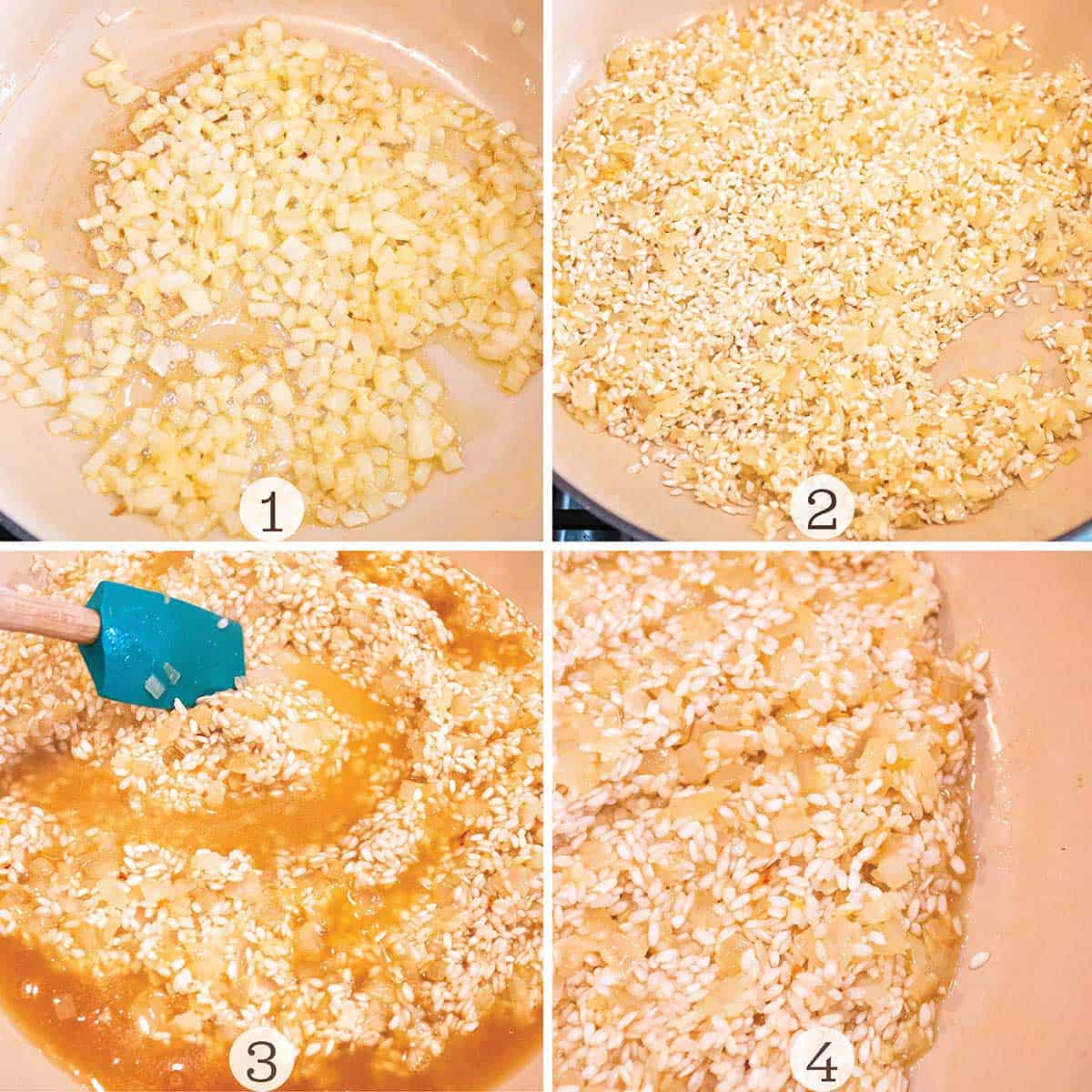
Step 3: Add in the onions and sea salt, and sauté until soft and translucent. (Image 1).
Step 4: Add in the garlic and cook for 30 seconds.
Step 5: Dump in the rice and toss to toast for a few minutes. It should start to have a nutty smell but not turn brown. (Image 2).
Step 6: Pour a ladleful of the warm stock into the rice, just enough to cover the rice. Stir to completely coat the rice. Stir continually, keeping the rice moving. (Image 3).
💡Pro Tip: You can take short breaks to allow the stock to simmer down but not long enough that the rice can become stuck to the pan.
Important: Do not add the next ladle of stock until everything has completely cooked out.
Step 7: Once the rice has absorbed all the liquid, pour in the next cup of the warm stock. Stir to incorporate. Allow the stock to cook out again, stirring as it reduces down. (Image 4).
Adjust the heat as needed. If it is taking a long time for the stock to cook down or if it is happening quickly adjust the heat.
It should be a nice gentle simmer and the rice isn't burning.

Step 8: Keep doing steps 6 & 7 until the rice is tender.
The rice should be cooked to al dente. Meaning it's tender but still a bit firm. Not crunchy though. Cooked too much more than this and it will be mushy. (Image 5).
📝Important Note: Do not wait to use up the stock. Go by the tenderness of the rice. If there is stock left over, that's okay. I like to have extra stock on hand just to make sure I don't run out. But it may not all get used.
Step 9: Once the rice is done, add in the lemon juice, fresh herbs, and crab meat. Taste and add more salt if needed. (Image 6).
Stir to fully incorporate and allow to cook for 1-2 minutes or until the crab is warmed up. The crab should be pre-cooked so it should only take a few minutes.
Total cooking time will all depend on how long the rice takes. Should take you about 30-40 minutes from start to finish.
Step 10: Remove the pan from the heat and fold in the parmesan cheese until melted.
Serve with some homemade sourdough bread or roasted asparagus.
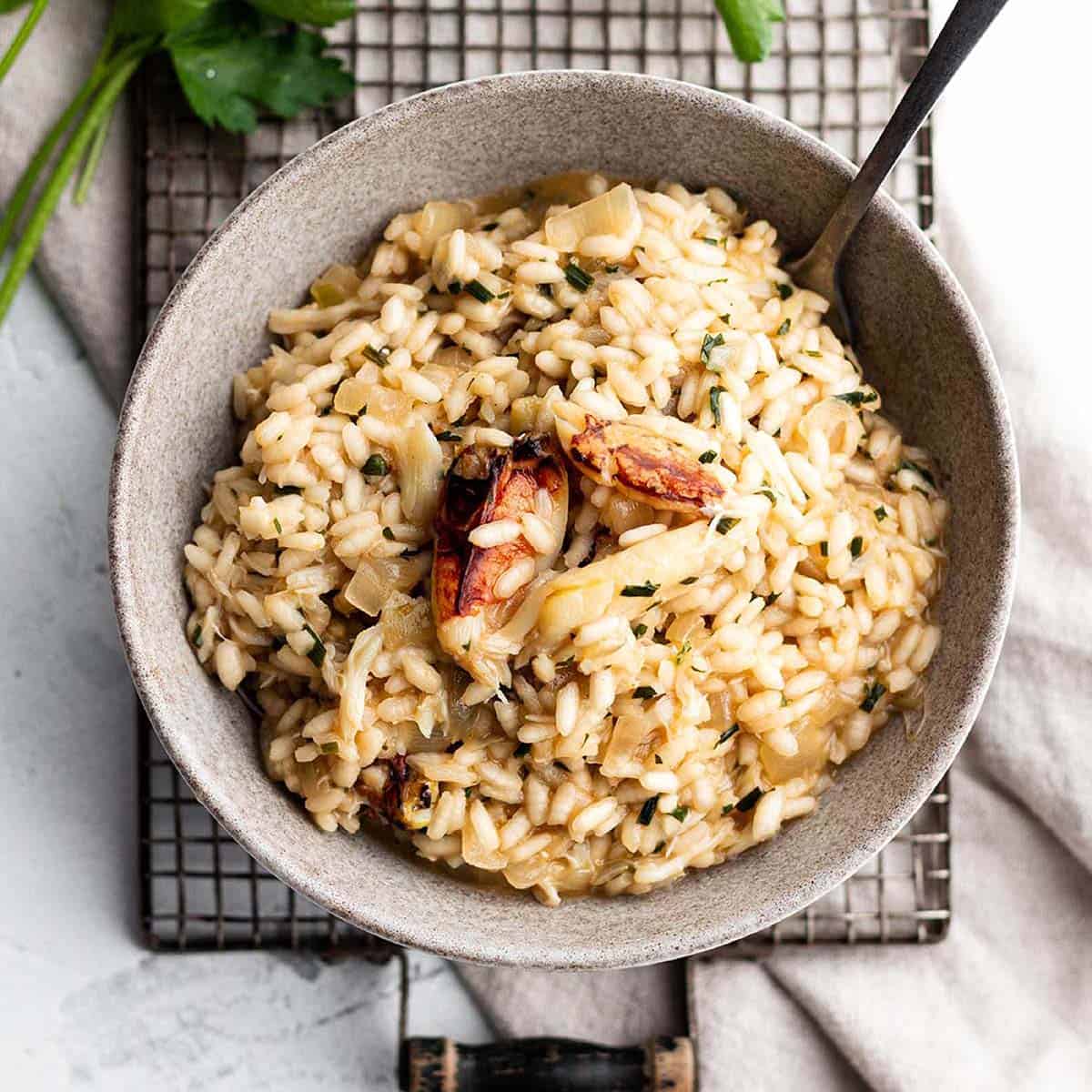
❓Recipe FAQs
Asparagus, brussels sprouts, sourdough bread.
Risotto is a rice dish that is slowly cooked with short grain rice like arborio or carneroli.
When stored in an air tight container in the refrigerator, crab risotto will last 2-3 days. If the crab starts to smell it might be time to toss it.
🦀Other Crab Recipes
📋Recipe
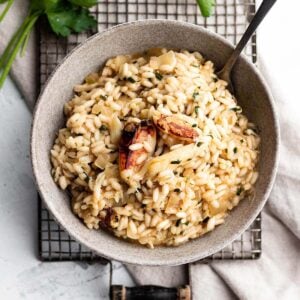
Crab Risotto
Equipment
- Medium Pot
- Wooden spoon or spatula
Ingredients
- 1 Tablespoon Olive Oil
- 2 Tablespoons Unsalted Butter
- 1 Medium Onion - Diced
- ½ teaspoon Sea Salt
- 2-3 Garlic Cloves - Minced
- 1.5 Cup Arborio Rice
- 5 Cups Broth or Stock - Vegetable, Seafood or Crab. See Notes
- 1-2 Tablespoons Fresh Lemon juice - About half a lemon
- 1 Tablespoon Fresh Chives - Chopped
- 1 Tablespoon Fresh Parsley - Chopped
- 8oz Fresh Crab Meat - Cooked
- ½ Cup Parmesan Cheese - Freshly Grated
Optional
- ¼ Cup Dry White Wine - Optional See Notes
Instructions
Warm Up the Stock
- Start off by warming the stock in a small saucepan over medium-high heat. Once it comes to a boil, reduce to low and keep the stock warm until the end.
- The stock should be held at a simmer, just below a boil for the entire cooking process.
Making the Rice
- In a pan or braiser, warm the olive oil and melt butter over medium-low heat. Add in the onions and salt, and sauté until soft and translucent.
- Add in the garlic and cook for 30 seconds.
- Dump in the rice and toss to toast for a few minutes. It should start to have a nutty smell but not turn brown.
- Optional: If you want to add the white wine this is the point to do it. Stir into the rice and allow it to completely absorb before moving on.
- Pour a ladleful of the warm stock into the rice, just enough to cover. Stir to completely coat the rice. Stir continually, keeping the rice moving. You can take short breaks to allow the stock to simmer down but not long enough that the rice can become stuck to the pan.
- Do not add the next ladle of stock until everything has completely cooked out.
- Once the rice has absorbed all the liquid, pour in the next cup of the warm stock. Stir to incorporate.Allow the stock to cook out again, stirring as it reduces down.
- Adjust the heat as needed. If it is taking a long time for the stock to cook down or if it is happening quickly adjust the heat.It should be a nice gentle simmer and the rice isn't burning.
- Keep doing this process until the rice is tender. The rice should be cooked to al dente. Meaning it's tender but still a bit firm. Not crunchy though. Cooked too much more than this and it will be mushy.
- Do not wait to use up the stock. Go by the tenderness of the rice. If there is stock left over, that's okay. I like to have extra stock on hand just to make sure I don't run out. But it may not all get used.
- Once the rice is done, add in the lemon juice, fresh herbs, and crab meat. Taste and add more salt if needed.Stir to fully incorporate and allow to cook for 1-2 minutes or until the crab is warmed up.
- Remove the pan from the heat and fold in the parmesan cheese until melted.
- Serve warm and enjoy!
Notes
-
- Don't rinse the rice. A risotto needs starch to cook correctly.
-
- Stir a lot but don't over-stir. The key to a good risotto is to keep the rice moving around. It also needs time to sit, so find that perfect balance of stirring and resting. Just make sure it doesn't sit too long where it burns and gets stuck to the pan.
-
- Cook slowly. The stock needs to be slowly incorporated and not cooked too fast.
-
- Warm stock up in another pot.
-
- Slowly add stock a little bit at a time.
-
- Cook just until al dente. Don't wait until the rice is super soft or it will become mushy.
-
- Cook rice at a slight simmer. It shouldn't be boiling but not too cool where the the stock won't cook down. Find that perfect middle ground. It may take some practice.
-
- Taste often. Toward the end of the cooking process, check the rice often to see if it is close to being done. You really do not want it to overcook.
-
- Do not rush it: Risotto can take time. It's better to cook it slower. If cooked too fast the inside will be crunchy.




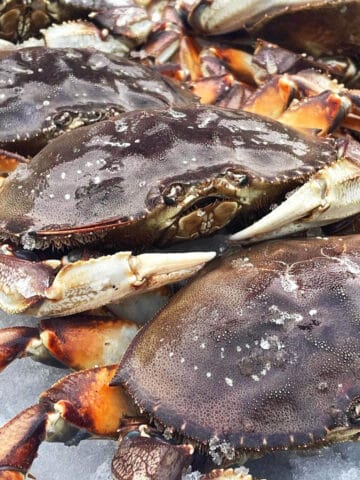
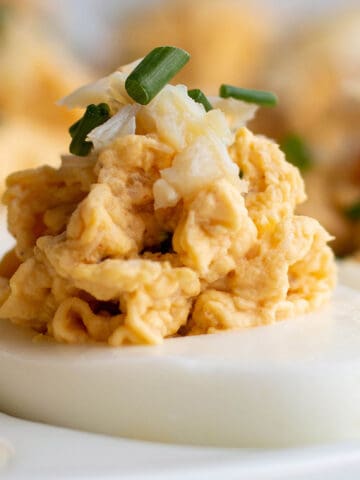

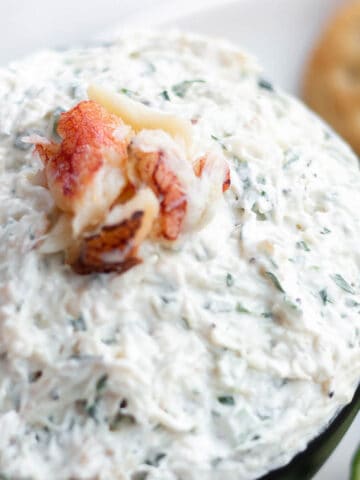



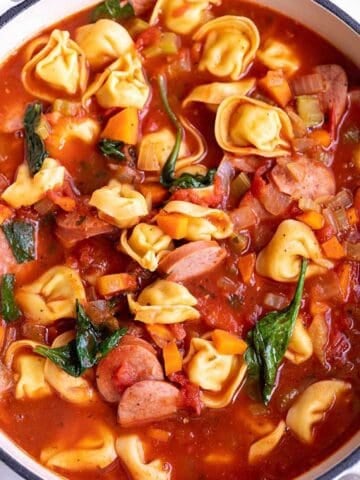
I like this recipe because it doesn’t include cream and can be modified without the butter for a more heart healthy meal. I increased the amount of herbs and I think the flavor and texture are excellent.
Thank you Cecily for your kind review. That is exactly what I was going for. A little lighter but still creamy.
We just tried this and it was so good! We have a subscription box of troll caught Alaskan seafood and recently received Dungeness Crab & found this via Pinterest.
This recipe came together easily & the final flavor was wonderful; comfort food for a cold fall evening. We did opt for the addition of white wine; 2 cloves of garlic (they were large cloves). We will be adding this to our 'keeper' file.
Teri, I am so thrilled you loved this as much as we do! Thank you so much for your kind review.